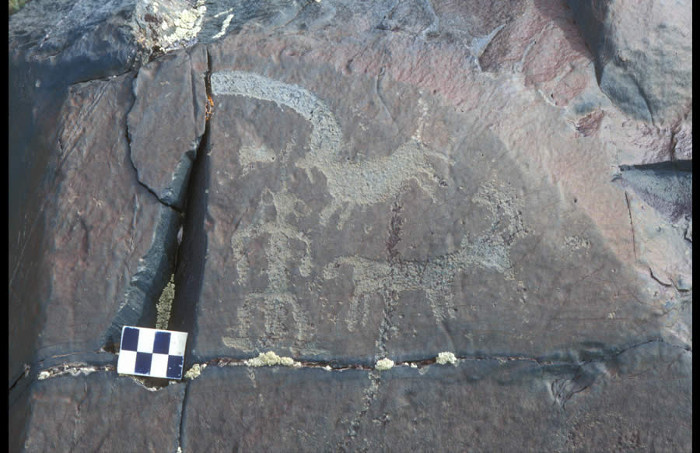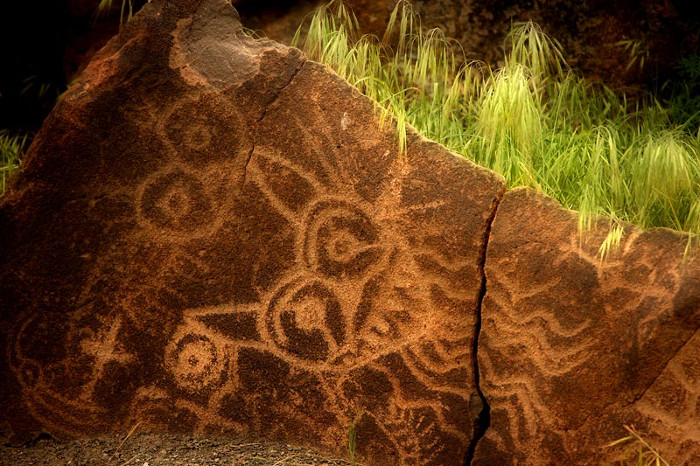Stone carvings in the Altai range
The United Nations Science, Education and Cultural Organization has recognized the Stone Carving in the Altai range of Mongolia as a World Cultural Heritage in 2011.

Altai in Mongolian means "golden", if anyone who has ever come to Altai will recognize that Altai is a legendary land, where legends can turn into reality.The Altai Range is one of the rare areas on the earth, the clearest place.
The petroglyphs of the Altai range are found to illustrate the development of culture in Mongolia over a period of about 12,000 years ago.

The stone carvings are focused on depicting the daily life of primitive people , hunting and gathering scenes . The following pictures show the transition to animal husbandry life and this model. continued centuries later. The next petroglyphs show that ancient inhabitants knew grazing and began to shift to nomadic life.
 The first paintings were carved in stone to the Altai Mountains with simple drawings.
The first paintings were carved in stone to the Altai Mountains with simple drawings.
The Altai range has three areas of stone carvings: the Bayan Area - Ulgii; Tsagaan Salaa Area - Baga Soum; Upper Tsagaan Gol area . All three areas have petroglyphs depicting the lives of prehistoric residents in Mongolia and on the Altai range.
These three areas of stone carvings are also located in high valleys separated from the glacier below. The paintings depict the living practices, rituals, hunting scenes and the general development of human culture over a period of 12,000 years ago.


There is a strong and intimate relationship between the stone carving art with the geographic nature of the mountain range, the concentration of corrosive substances from the glacier and the life and habit of the residents of that period. The petroglyphs in the Altai Mountains are the most complete memorandum of the history of intersection residents in Central and North Asia.
 The paintings of the following period describe the pastoral animals of the prehistoric inhabitants with more sophisticated drawings .
The paintings of the following period describe the pastoral animals of the prehistoric inhabitants with more sophisticated drawings .
Stone carvings in the Altai Mountains are recognized as Unesco Heritage by the following criteria:
Criterion (iii): Stone carvings in Mongolia's Altai range provide particularly important documents in the evolution of the community from tens of thousands of years ago, especially the development of the community in the communities. intersection of Central and Northern Asia.
Petroglyphs also tell scientists about the animals that once lived in the Altai range such as mammoths, ostriches, rhinos, elephants, tigers . These animals are simply drawn with static configuration lines. In addition to the above criteria, petroglyphs on Altai range are also recognized by the integrity of this heritage. All three areas have adequate scientific evidence of community evolution. All three areas are a complete record of human culture during the last 12,000 years.

Not until it was recognized as a World Heritage Site, but the stone carvings received the attention that had previously focused on the preservation of this heritage. In 2008, according to the provisions of the Law on Protection of Mongolian Cultural Heritage, all three regions included Bayan - Ulgii Area; Tsagaan Salaa Area - Baga Soum; The Upper Tsagaan Gol area is listed as a special protected area. In the law, it is very clear about the protection of natural environment including water resources, atmosphere as well as restrictions on urban development.

In 2012, the Mongolian Cultural Heritage Protection Law was revised by the Government. Accordingly, the regulations on heritage conservation are given more stringent and detailed. It is particularly noteworthy that in order to protect the integrity of this World Cultural Heritage, managers have given ideas to protect the traditions of local people, as this is also Extremely important factor in Unesco's choice and recognition of Heritage. Nomadic people are propagated and learned about the importance of heritage as well as the sense of preserving the heritage where they live.
Although not really attractive, the Altai mountain range in general and the Altai stone carvings in particular are great tourist potentials of Mongolia.
- Brazil discovered a 10,000-year-old stone carvings
- Mysterious carvings on stone
- Scientists found a Buddha image carved in stone in Siberia
- Mysterious prehistoric stone carvings in Scotland
- Princess mummy 'causes earthquakes'
- The carving depicts the oldest description of a supernova
- Discovering stone carvings of 2.6 million years old
- Discover the most ancient mysterious carvings of North America
- Display the 2,000-year-old stone carvings written in the name 'Jerusalem' in Hebrew
- Stone carvings in Tamgaly archaeological area
- Humanity survives thanks to the Altai climate
- Stone carvings in Alta - Norway
 Suzhou classic bonsai garden - China
Suzhou classic bonsai garden - China Chau Nguyen Dynasty
Chau Nguyen Dynasty Thai Son Mountain - World Wonder
Thai Son Mountain - World Wonder Ancient villages of Shirakawa-go and Gokayama
Ancient villages of Shirakawa-go and Gokayama